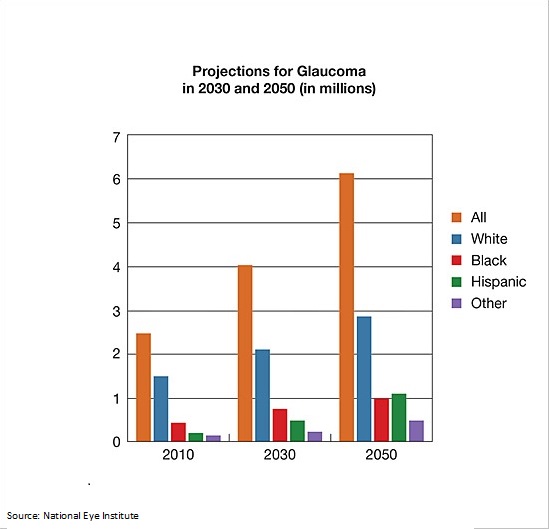April 3, 2020 by John Fernandez
Saving Your Vision From Glaucoma

It’s not exactly a scientific analogy, but ophthalmologist Aarup Kubal, M.D., likes to compare glaucoma to clogged pipes.
“When I talk to patients, I describe glaucoma as being like a plumbing problem. There’s too much fluid in the eye, and we have to find a way drain it,” said Dr. Kubal, a surgeon at Baptist Eye Surgery Center in Sunrise.
It’s important for everyone to have an understanding of glaucoma, he said, since this eye condition can cause irreversible vision damage and even blindness. Even those who haven’t been diagnosed with glaucoma should be aware of it so they take steps to protect their vision. Early treatment is key.
What is Glaucoma?
 Glaucoma is a group of eye diseases that gradually steal sight without warning. Vision loss is caused by damage to the optic nerve, which is like a data cable coming out the back of the eye. In most cases, the nerve, which carries visual information to the brain, is eroded by elevated pressure in the eye.
Glaucoma is a group of eye diseases that gradually steal sight without warning. Vision loss is caused by damage to the optic nerve, which is like a data cable coming out the back of the eye. In most cases, the nerve, which carries visual information to the brain, is eroded by elevated pressure in the eye.
Currently, more than 3 million people in the United States have glaucoma. The National Eye Institute projects that number will continue to rise to 4.2 million by 2030, and potentially double by 2050.
Although it is a leading cause of blindness, experts estimate that half of those who have glaucoma don’t know it, leaving it untreated. There are virtually no symptoms for the most common forms of glaucoma, and without a comprehensive eye exam people may not detect its effects for years.
“As glaucoma progresses, the vision loss is very subtle. People tend to compensate for it without even noticing,” Dr. Kubal explained. “They don’t realize they have lost vision until it is too late.”
Vision loss begins with peripheral or side vision, and much as 40 percent of vision can be lost without a person noticing, according to the Glaucoma Research Foundation. The damage is irreversible.
Reasons to be Hopeful
There is no cure for glaucoma — yet — but vision damage can be reduced or avoided through treatment that lowers the pressure in the eye. In some cases, this involves daily eye drops, but patients may also be candidates for laser treatment or even traditional surgery that improves the eye’s drainage system. Treatment plans depend on factors unique to each patient.
Technology to treat glaucoma continues with evolve with astonishingly tiny medical devices, such as implants that are the size of a single letter on a penny. One of those devices, the iStent, has been the treatment of choice for many patients also undergoing cataract removal at the Baptist Eye Surgery Center in Sunrise and the Center for Excellence in Eye Care at based at Baptist Hospital and West Kendall Baptist Hospital.
Dr. Kubal hopes to soon begin offering two additional implantable devices recently approved by the Food and Drug Administration to relieve pressure in the eye by draining excess fluid to different areas.
Meanwhile, researchers are investigating whether it might be possible to replace glaucoma eye drops with contact lenses that release medication. Research is also underway to look at whether stem cell secretions may protect against glaucoma.
“There are a lot of new things coming out,” Dr. Kubal said. “We’re always looking for a better procedure, a better way to treat glaucoma and reduce risk.”
What You Can Do
You can’t benefit from the breakthroughs in the field if you don’t know you have glaucoma, however.
If you think only senior citizens get glaucoma, you’re wrong. Although glaucoma is more common in middle aged and older people, even babies and children can get a form of early onset glaucoma. Those most at risk are people with a family history of glaucoma, those with diabetes, and African Americans over the age of 45. But the bottom line is anyone can develop glaucoma.
Because of that, getting a regular comprehensive eye exam is crucial, Dr. Kubal said. During a comprehensive dilated eye exam, drops are placed in your eyes to widen the pupil. Your eye care professional then uses a special magnifying lens to examine the back of your eye and look for signs of damage or problems. It’s the best way to catch glaucoma early, yet it’s a part of overall health care that people often neglect.
“A lot of people put off eye health. If they are not experiencing problem with their eyes and haven’t noticed a change in their vision, they may skip a comprehensive exam,” Dr. Kubal said. He’d like to see that change. “It is ingrained in us from the time we are children that we have to go to the doctor regularly for a checkup, that we have to go to the dentist. But people are not getting the same message about eye health.”
top stories












There are no comments